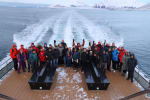The time has come for our current winterovers, Marc and Hrvoje, to pass the torch to the new winterovers that arrived at the South Pole last week. As a winterover, individuals brave the unforgiving environment to spend a year—sometimes longer—at the South Pole, half of which is enveloped in complete darkness. Every year, two winterovers […]
WIPAC
WIPAC news that we’re hiding.
SCAR AAA meets above the Arctic Circle for 7th workshop
The seventh meeting of the Scientific Committee on Antarctic Research Astronomy and Astrophysics from Antarctica (SCAR AAA) was held September 19-21, 2023, about 1400 km from the North Pole in the northernmost town in the world, Svalbard, Norway. The three-day workshop brought together dozens of researchers from nine countries to discuss, coordinate, and promote astronomical and astrophysical activities in Antarctica. […]
Carlos Argüelles-Delgado named a 2023 Packard Fellow for Science and Engineering
IceCube collaborator and Harvard physics professor Carlos A. Argüelles-Delgado was named a 2023 Packard Fellow for Science and Engineering. Packard Fellowships are given to early-career scientists and engineers “who are boldly pursuing new areas of research.” As a Packard Fellow, Argüelles will receive $875,000 in unrestricted funds that can be used over five years in […]
Second ThaisCube workshop strengthens partnership between IceCube, Thailand
Last week concluded the 2nd ThaisCube workshop held in Chiang Mai, Thailand, a program that developed from a partnership between Chiang Mai University (CMU) in Thailand, the National Astronomical Research Institute of Thailand (NARIT), and the IceCube Neutrino Observatory. The workshop brought together IceCube researchers, Thai scientists, and aspiring young students. Held on August 8-11, […]
Lu Lu receives 2023 IUPAP Early Career Scientist Prize
IceCube collaborator Lu Lu received a 2023 International Union of Pure and Applied Physics (IUPAP) Early Career Scientist Prize “for her contributions to the development of high energy neutrino astronomy in the PeV energy region.” Lu accepted the award on July 27 during the opening ceremony at the 38th International Cosmic Ray Conference (ICRC) held […]
IceCube search for sub-TeV neutrino emission associated with LIGO/Virgo gravitational waves
Gravitational waves (GWs) are produced by some of the most extreme astrophysical phenomena, such as black hole and neutron star mergers. They have long been suspected as astrophysical sources of neutrinos, ghostlike cosmic messengers hurtling through space unimpeded. Thus far, common astrophysical sources of neutrinos and photons, as well as common sources of gravitational waves […]
IceCube Receives Honors in 2022 HPCwire Readers’ and Editors’ Choice Awards
The IceCube Neutrino Observatory has been recognized in the annual HPCwire Readers’ and Editors’ Choice Awards, presented at the 2022 International Conference for High Performance Computing, Networking, Storage, and Analysis (SC22), in Dallas, Texas. The list of winners was revealed at the SC22 HPCwire booth as well as on the HPCwire website: www.hpcwire.com/2022-hpcwire-awards-readers-editors-choice. […]
IceCube analysis indicates there are many high-energy astrophysical neutrino sources
Back in 2013, the IceCube Neutrino Observatory—a cubic-kilometer neutrino detector embedded in Antarctic ice—announced the first observation of high-energy (above 100 TeV) neutrinos originating from outside our solar system, spawning a new age in astronomy. Four years later, on September 22, 2017, a high-energy neutrino event was detected coincident with a gamma-ray flare from a […]
Newly discovered optical effect allows IceCube to deduce ice crystal properties
Every second, 100 trillion neutrinos pass through the human body. These tiny, almost massless particles travel tremendous distances through space while carrying information about their sources and are created by some of the most energetic phenomena in the universe. But neutrinos are incredibly difficult to detect, requiring a one-of-a-kind detector that can “see” these nearly […]








